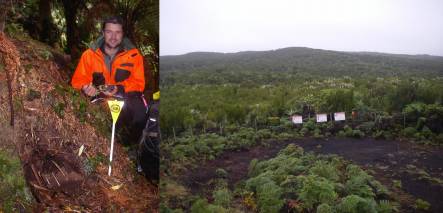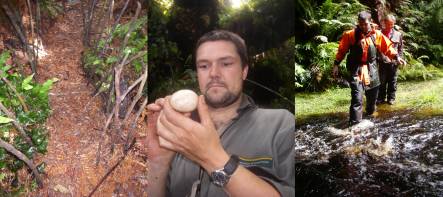
Pat Liddy next to a taiko burrow with a 'stick fence' in the entrance, and view of the Tuku valley (images: A. Ballance)
In 1867 a few small seabirds were seen and caught in the mid Pacific, halfway between South America and New Zealand. Italian scientists described them as magenta petrels, but no one knew where they bred. For over a hundred years the magenta petrel was considered extinct, until David Crockett rediscovered them on the Chatham Islands in 1987, after 9 years of looking for a bird that the local Chatham Islanders knew as the taiko. Today, taiko are one of our rarest birds, thought to number just 150 or so birds. Only 17 breeding pairs are known. The birds breed in dense forest in the Tuku Valley in the south of the main Chatham Island, where the Department of Conservation runs an intensive predator trapping programme to protect the birds from rats, cats and feral pigs. Each breeding burrow is monitored weekly, and Alison Ballance joins Department of Conservation ranger Patrick Liddy for his weekly check, during which he finally takes a peek at the last two eggs of the season. One egg was infertile, which took the chick tally for 2010 to 13. Since this story was recorded all 13 chicks were moved to the predator-proof Sweetwater Covenant for the last few weeks before they fledged, in the hope they will return there in 4 or so years. The last chick left its burrow in the middle of this week.

The sticks guide feral cats over a leg-hold trap hidden under leaf litter in the middle of the track, Pat Liddy with an infertile taiko egg, and crossing the Tuku River in flood (images: A. Ballance)

